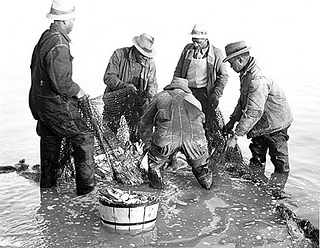See also: Menhaden Chanteymen.

Work songs are sung as an accompaniment to work, primarily manual labor. They are usually traditional in nature, circulating among workers in a given occupation. Tasks such as shucking oysters, hoeing crops, and cutting wood involve repetitious action, and workers often sing to pace the work and pass the time. Other tasks, including hauling in fishing nets, involve the coordination of effort among several workers. For these tasks, song provides a cue for physical action as well as a way to pass the time. In the 1920s, Guy B. Johnson and Howard W. Odum studied work songs in North Carolina, collecting many of their texts from laborers on the University of North Carolina campus in Chapel Hill. As the nature of work changed with increasing industrialization the need for these songs decreased, but some work songs specific to particular activities and conditions persisted. Many songs emerged from the textile industry that commented on the conditions of work in the mills.